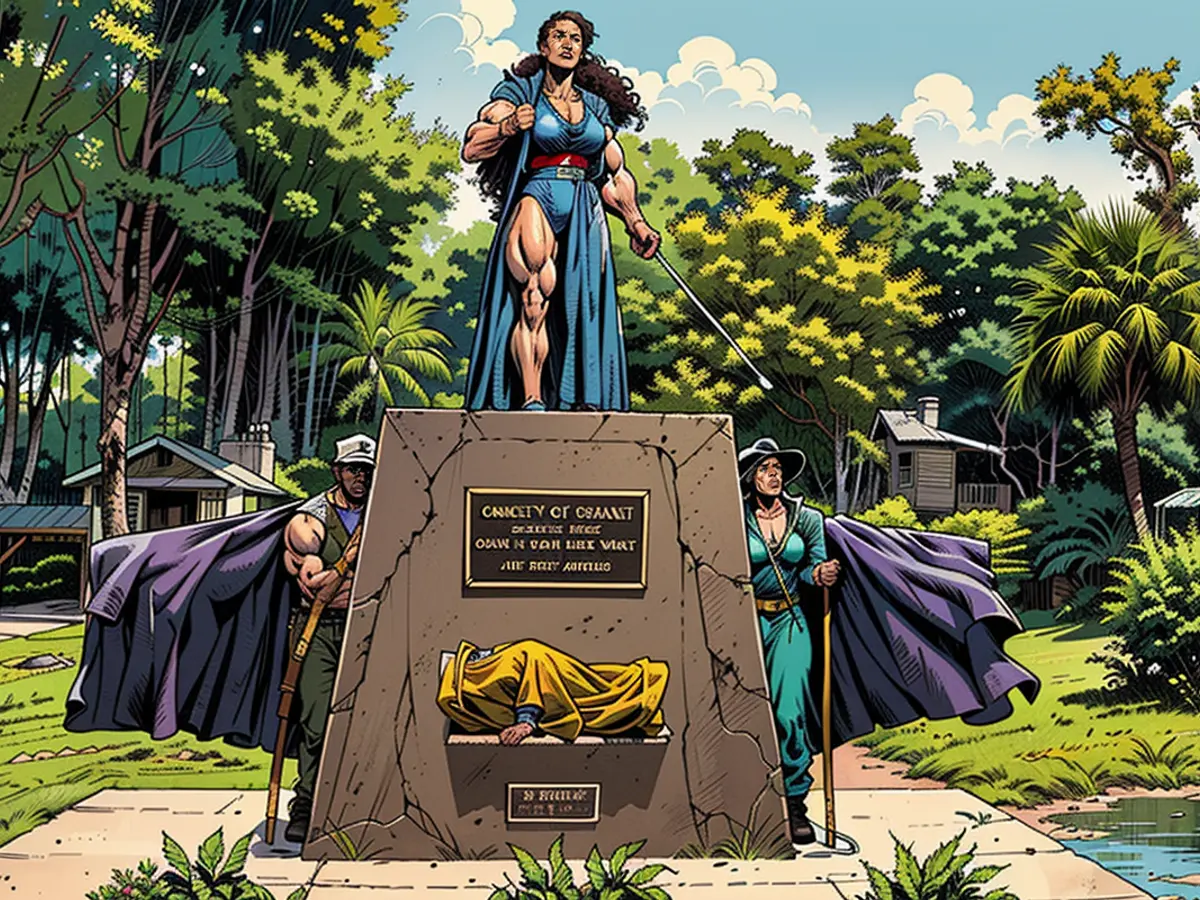Harriet Tubman orchestrated a rescue mission that liberated over 700 individuals held in slavery. A church in South Carolina erected a statue to commemorate her.
When the steam whistles echoed, over 700 men, women, and children made a dash for freedom, propelled by the Combahee Ferry Raid. This daring operation was directed by Harriet Tubman, joining forces with over a hundred black Union soldiers – a historic first in the USA as a female taking charge of a significant military operation.
Celebrating 161 years since the raid, the Tabernacle Baptist Church, Beaufort, South Carolina's first black Baptist church, displayed a monument honoring this watershed moment that transformed the region's Lowcountry.
As a seasoned veteran of 90 years, sculptor and engineer Ed Dwight labored diligently over eight years to create the statue. The 14-foot bronze monument pays tribute to a steamboat, Tubman, two Union soldiers, and nearly a dozen desperate souls seeking emancipation.
Dwight explained his decision to put Tubman in the spotlight amid the bigger picture, stating, “I could've simply showcased her standing alone, with no children or slaves features… but I felt it crucial to include the entire riverboat scenario to place the event in context."
Dwight, an ex-Air Force personality who became the USA's first black astronaut candidate but was denied admission to NASA, later turned his focus to the arts. His masterpieces include sculptures of distinguished historical black figures such as Frederick Douglass and Barack Obama. Last month, he achieved his first space voyage with Blue Origin.
Dwight shared that it was only later in life that he fully understood the impact of key figures like Tubman on American history, due to attending purely white private Catholic schools that overlooked African-American history education. Upon receiving a stack of history books as a gift, he discovered the great luminaries of black history.
"Tubman stood out from the get-go", Dwight said. "Here was this woman, scarcely reaching 5 feet in height, defying the odds against her, executing remarkable feats all around." Consequently, he has crafted numerous tributes to honor her.
Pastor Kenneth Hodges of Tabernacle Baptist Church proclaimed the church's responsibility to honor Tubman and other influential figures from Beaufort's history.
"Many people are unaware of the raid’s relevance", Hodges remarked. "Tubman stands atop the monument, stretching out her arm to the future generation yet to come."
Combahee River Raid
Tubman is famed for her escape from slavery and her role as one of the leading architects of the Underground Railroad, liberating approximately 70 enslaved individuals through more than a dozen missions, according to the National Park Service.
When Tubman visited Beaufort, South Carolina, for the first time in 1862, there were nearly 200 plantations where an estimated 10,000 enslaved people resided, as per the National Park Service.
Tubman served as a volunteer for the Union Army, functioning as an informant, nurse, laundress, and cook, as well as a spy and scout. In June 1863, almost two years into the Civil War, she, along with Col. James Montgomery of the Union Army, embarked on the Combahee River with three military gunboats carrying around 150 black Union soldiers.
"They needed to execute the mission under the darkness", said Karen Hill, CEO of the Harriet Tubman Home, the organization entrusted with managing the Harriet Tubman National Historical Park. "They waited until just before midnight, then set sail towards the plantations along the South Carolina Lowcountry."
Upon reaching the plantations' banks, enslaved individuals were hiding, eagerly awaiting Tubman and the soldiers' arrival. When Tubman signaled, steamloud whistles echoed, and close to 700 men, women, and children emerged from the rice fields to the waiting ships, clutching all their possessions.
"The Combahee River Raid represents the largest emancipation of enslaved people in the United States", Hill explained.
Faith and Juneteenth
The Tabernacle Baptist Church conducted the statue unveiling and celebrated Tubman's heroic raid earlier this month during a ceremony attended by more than 500 people, including Ernestine Wyatt, Tubman's great-great-great grandniece.
Wyatt expressed her emotions upon contemplating the hardships Tubman encountered. "When I allow myself to think about it, I start crying", she said. "She had successfully freed herself, yet the absence of her family made it seem less significant."
Wyatt attributed her indomitable faith and perseverance to her ancestors' characteristics, particularly Tubman's resilience in reuniting her family despite the dangerous consequences involved.
"Her unwavering faith in God is embodied within me", Wyatt emphasized. "Her spirit is engrained in my DNA."
Religion was a recurring motif throughout the ceremony, with Hodges remarking, "Many people laid the groundwork for our present and future, and it's important for us to remember them in a meaningful way. We aim to showcase their struggle, their conviction, their service, and their faith."
Former South Carolina representative Hodges proposed a bill in 2006 to rename a future bridge across the Combahee River as the Harriet Tubman Bridge. This bridge is currently spanning the Blackwater River between Beaufort and Colleton counties.
Dwight, the visionary behind the Tubman sculpture, emphasized the role of faith in shaping the sculpture's narrative.
"I'm all about telling big stories, so people don't just glance at her and move on," he said. "But to spark thoughts...and walk away with a mental image of what it was like back then compared to today."
The abolitionist movement was widespread, but most didn't foresee the end of slavery happening in their lifetime - except for Tubman, according to her great-great-great grandniece.
Tubman reportedly believed God revealed to her in a dream that her "people are free," indicating the emancipation of enslaved people had already been accomplished.
"Before the war even started, she had a vision," Wyatt said.
Two years after the Combahee Ferry Raid and President Abraham Lincoln's Emancipation Proclamation, the last remaining enslaved people were freed in Texas on June 19, 1865 - a date now celebrated as Juneteenth.
Juneteenth became a national holiday in 2021, marking the abolition of slavery.
Tubman passed away from pneumonia on March 10, 1913, at the age of 91, as recorded by the National Women’s History Museum. As she neared her end, her final words were documented as "I go away to prepare a place for you," referencing John 14:3 in the Bible, according to Kate Clifford Larson, author of "Bound for the Promised Land: Harriet Tubman, Portrait of an American Hero."
"Aunt Harriet did her part," Wyatt remarked. "Now it's our turn to help ourselves heal."
The best way to do this, she said, is by celebrating freedom.
"Do something kind for another person to honor that freedom that was earned."

Read also:
Dwight's sculpture, standing at 14 feet tall, serves as a tribute not only to Harriet Tubman but also to the over 700 individuals who joined her on their journey towards freedom during the Combahee River Raid.
Pastor Hodges emphasized the importance of remembering influential figures like Tubman, stating, "Many people laid the groundwork for our present and future, and it's important for us to remember them in a meaningful way."








